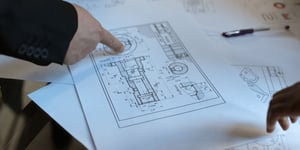Are there changes you could make to better your current product or process?
Design changes are crucial in die cut converting.
Because you’re using a unique part drawing to run a custom process, the odds of encountering issues are higher than you may anticipate. You might run into problems with the part application, performance, or packaging that could warrant a design change.
While we are not a true design house here at Strouse, we have helped transform most of our customer’s part designs. We aim to help our clients’ designs become more manufacturable versions of themselves. To give you a more specific idea of what we’re talking about, let’s look at some part changes that could be alterations in your manufacturing design:
What Qualifies As a Change in My Manufacturing Design?
Flexible material converting can be a sensitive process, so you can consider any change to the part design, packaging, or process as a potential roadblock.
Here are some examples of changes in manufacturing design:
1. GEOMETRICAL SHAPE
Changing the geometrical shape will usually result in new tooling, which could be more expensive depending on the complexity of the new part design and its tolerances.
2. MATERIAL (Substitution, Addition, or Subtraction of)
A change in the material of your part could result in new tooling, re-tooling, or no new tooling at all. However, changing the material of your part also risks changes in the material price and machine run process.
3. PACKAGING OR DELIVERY
To achieve maximum efficiency using a rotary press, your converter’s goal is to feed material into one side and receive finished parts out of the other. Changing how you want the parts arranged on the liner, stacked, connected, boxed, or pouched will result in changes to the machine run process.
Review these points before changing your die cut part design to understand why you should consider linking up with a converter during a re-design to avoid any financial ramifications due to part changes.
3 Factors You Should Consider When Changing a Die Cut Design
It’s best to involve your flexible material converter in your design process, even if that means providing updates.
A quick email is all you need to bring your converter into the fold:
“We’re having issues with ___, so we’re trying to identify design problems and potential solutions.”
Adjustments that appear simple to you could completely alter your converter’s process, costing thousands in tolerances, material substitutions, and re-tooling. These three factors demonstrate how your design changes alter our converting process:
1. COST
The cost of your die cut part depends on multiple design aspects, the most significant being the complexity of its tolerances. Tightening your part tolerances can double your unit price depending on what you’re changing due to the high tooling cost and a decreased margin of error.
Die cut tolerances determine the acceptable margin of error for your part measurements. Changes could lead to complex tooling purchases, increased frequency of quality inspections, and a larger amount of material waste.
Tight tolerances are an industry-wide struggle, and when converters tell you they’ll produce your tight tolerance part with no problem “compared to the other guys,” ask how much it’s going to cost you.
Although you might be tempted to re-design your part and fix an issue immediately, plan to discuss your tolerances with a flexible material converter instead. You don’t want to end up with a part with monstrous pricing because its tolerances are challenging to meet.
2. LEAD TIME
Certain product issues might make you interested in adding to, subtracting from, or substituting the material on your part. Yet, this could cause major changes in the cost due to the material lead time, Minimum Order Quantity (MOQ), and potential tooling changes as well.
When you change your material, you might be changing the material lead time, MOQ, and tooling without ever even realizing it. The MOQ impacts the price and schedule of your materials, and buying a different amount than usual or swapping out an existing material will disrupt the balance between cost and shipping time orchestrated by your converter.
Your product’s effectiveness isn’t the only aspect disrupted by changing the material. In addition, your converter must consider whether the process materials, like the liner or guide material used during production, have been affected.
Material changes can be tricky, but they’re often necessary for the sake of your project. If you’re interested in testing different materials for one of your existing part designs, let us help you try something new:
You might not know about every factor involved in building your part, so we recommend giving your flexible material converter a heads-up that you’re looking into other options before spending your time and resources on a product re-design.
3. FEASIBILITY
Tighter tolerances are more expensive because they rely on more complex tooling designs. The feasibility of your tolerances will affect your tooling price, and changes in either your die cut tolerances or materials could affect your current tooling.
Changing your material could result in new tooling, re-tooling, or no new tooling depending on how similar it is to the previous material. In addition, your partial tooling won’t always cover significant changes in design.
If you’re using laser or digital cutting methods, there’s no need to be concerned about re-tooling. However, re-tooling could be one of your biggest expenses if your project uses rotary die cutting. Re-tooling isn’t as easy as visiting the hardware store; your die cut tool is custom-made, and the new tool might cost significantly more than the last.
If your new material is similar to the previous in terms of thickness and composition, your converter likely won’t need to replace the entire tool. On the other hand, if it leads to a change in liner or guide materials, you may have to re-tool your existing tool (a.k.a. pay to have it adjusted).
When the new material is substantially thicker, more abrasive, or more flexible than the original, converters often purchase new tools to cut the design accurately.
Lastly, changes to the packaging requirements of the part itself might lead to a re-tool if they’re significantly different from the original process. Asking for additional features, such as perforation, could result in the need for tooling alterations.
Preparing For Design Changes in Manufacturing
As perfect as a new design may seem, unless you’ve consulted your converter about the potential changes, it might not be built for manufacturability.
In certain situations, your converter might suggest part adjustments to ease the difficulty of production, improve your part, or save money.
The more involved Strouse is, the more we can use our knowledge to help you. For instance, we’ll ask follow-up questions, such as:
- Have you tried different materials?
- What other designs have you gone through?
- Does your application involve automation?
- What have you tried before?
As your flexible material converter, we don’t want to reinvent the wheel that doesn’t work. Therefore, we would greatly appreciate hearing about your part’s previous designs and any issues with them.
Solving a problem is the crucial motivation for a design change, and when you bring your flexible material converter into the loop, it becomes a collaborative design effort.
Instead of going at it alone and risking wasted time and effort, get in touch with us and see how we can use our current capabilities to help improve upon your existing design.








